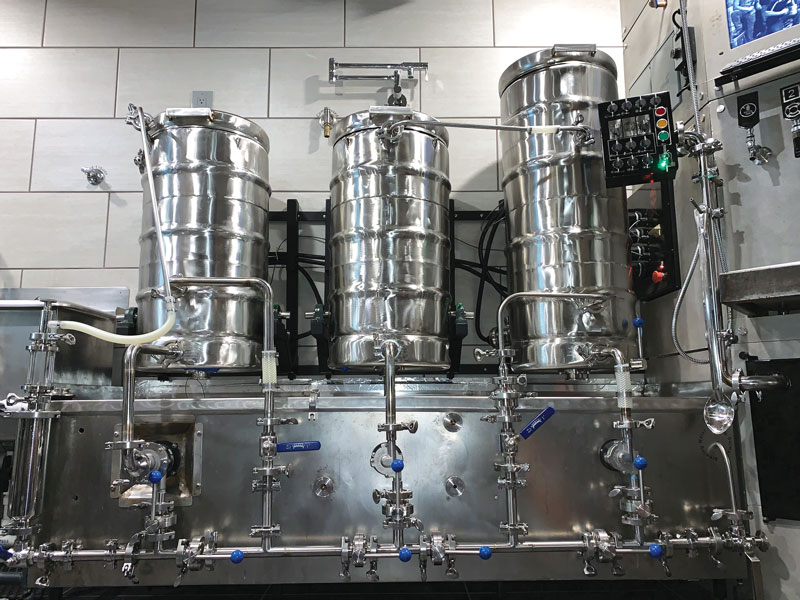Yeast Management: Tips From the Pros
Yeast are a keystone piece in the development of our beers. Provide them with proper room and board, treat them with respect, and these microbes will work miracles. Learn from two masters of fermentation who cover pitch rates, repitching, and oxygenation.
Brewer: Zach Miller Victory Brewing Co., in Downingtown, Pennsylvania
Yeast cells have a finite lifespan, as measured by number of divisions and not by chronological age. This lifespan is largely species- and strain-specific. When a yeast population gets towards the end of its collective lifespan, the time it takes for cellular division increases sharply and you can end up with slow or stalled fermentations as a result. The disposal of yeast populations after a set number of generations is largely to avoid this sudden decrease in fermentation performance.
A good analogy for the reuse of yeast is a sprinter at a track and field event. They will run multiple sprints throughout the day, but over time their speed will decrease because of exhaustion. Once our “times” start to increase, that signals when we look to replace the “sprinter.” Generally speaking, we reuse our yeast though it is heavily dependent upon the strain and fermentation vessel conditions. We get heavy use of most of our ale strains, typically lasting upwards of 20 generations before going back to our yeast bank. Lagers, on the other hand, will only last about 10 generations for us.
We also bank our own yeast in a -112 °F (-80 °C) freezer. We maintain about 70 strains, using a glycerol solution to prevent the cells from lysing due to the formation of internal ice crystals. Our yeast can be stored almost indefinitely under these conditions, so we always have master cultures to return to. From these masters we make a 6-month supply of slants to pull from as necessary, and can then scale up to industrial-sized batches whenever we need.
We would not recommend washing your yeast, acid or otherwise. By washing your pitching yeast, you are depleting their glycogen supply which is needed to initially power sterol synthesis, and also for smooth transition through ordered uptake as the cell shifts from glucose to maltose and maltotriose. In short, you could be handicapping your yeast right before pitch and setting the stage for poor membrane function or issues with carbon catabolite repression.
All that being said, since we don’t wash our yeast, trub levels do become an issue in flocculated yeast. In order to prevent transferring too much trub, we drop it from the bottom of our conical fermenters about 24–48 hours after the tank is full. After that window has closed, yeast will begin to flocculate into the cone where it will be ready to harvest with much lower trub levels. When reusing yeast, via a washing method or direct pitching, consistency with trub levels is key.
At Victory, ales are pitched at 1 million cells per mL per degree Plato. Lagers are pitched at 1.25 million cells per degree Plato. Slower-fermenting lager strains need a higher pitch rate to keep overall fermentation times reasonable, which in turn reduces their exposure to the stressful conditions of late-fermentation. A modestly higher pitch rate also keeps ester production minimal for a cleaner flavor, which is desirable in most lager brands.
The same premise of reducing stress can be applied to high gravity brewing, where yeast are taxed heavily with osmotic stress at the beginning of fermentation and also towards the end of fermentation when consumable sugar is low and ethanol concentration is high. To help our yeast population pull through these conditions in relatively good shape overall, we pitch at a higher level. For every degree Plato above 16 °P, we add an additional 1 million cells per mL. For instance, if we brewed 20 °P ale wort we would pitch 24 million cells per mL, 20 million cells per mL to cover the sugar concentration and an additional 4 million cells per mL to help compensate for the extra-stressful conditions.
We significantly increase wort oxygenation for high gravity beers. Oxygen solubility decreases as wort gravity increases, so we need to add more to hit a target dissolved oxygen content. Oxygenation is critical at the beginning of fermentation since yeast require it for the biosynthesis of sterols and unsaturated fatty acids. In particular, sterols are critical to proper cell membrane formation and function. These sterols are used for cell growth and cell division, and also regulate membrane fluidity and membrane permeability. There needs to be enough oxygen in the wort to synthesize sterols for all of these processes to be healthy throughout the yeast population, which is higher initially due to the increased cell count.
Brewer: John Kimmich The Alchemist, in Stowe, Vermont
When it coming to re-pitching yeast, we actually use our yeast for 6 generations before switching out with a fresh culture. Through many years of experimentation, I have found that this is the range that produces the best ester profile for us. Yeast goes through many changes during subsequent generations, and if you graphed it out, it would be a wave with high points and low points. I have found that 10-14 is a ‘low’ point, and then it rebounds. In a brewpub setting , that is acceptable, but not on a commercial production scale. But I do not wash yeast between generations.
On a homebrew scale, I would probably just absorb the cost of pitching with a fresh yeast culture with every batch. Saving yeast is a tricky thing, and the smaller the volume of your stash, the harder it is to keep it alive and healthy. Unless you are fermenting in a temperature controlled cone, it is difficult to collect a clean sample. The best place to store yeast is under a freshly fermented beer, but only for a couple days. If you want to store yeast for longer than that, I would keep a small keg of unfermented wort in my fridge, and use that to layer the yeast in a container. Do not add oxygen. Put an airlock on the container, and the sugars in the unfermented wort will slowly ferment and provide food for the yeast.(always cold! 36-38 °F/2–3 °C) Even with this technique, you will really only add a week or two to your viability window.
I only adjust my pitch rate when we do big beers like our big imperial stout, Luscious. When you get well into the 20s °Plato on your starting gravity, a larger pitch is a must. As for a beer like Heady Topper, one our Double IPAs, we have to find the balance of creating the desired ester profile, while also getting the beer to ferment in the proper amount of time. On a standard beer (10-19 °P), a smaller pitch can work and produce a heavier ester character, but a larger pitch can get things moving quicker.
For the most part, when aerating in-line during chill/transfer, you want to add enough oxygen to promote growth and fermentation. However, if you are putting in more than the wort can absorb, you will create foam in your fermenter, and you will potentially scrub out hop character. We don’t feel that adjusting the aeration level of the wort is a necessary thing, but maybe just a little.





